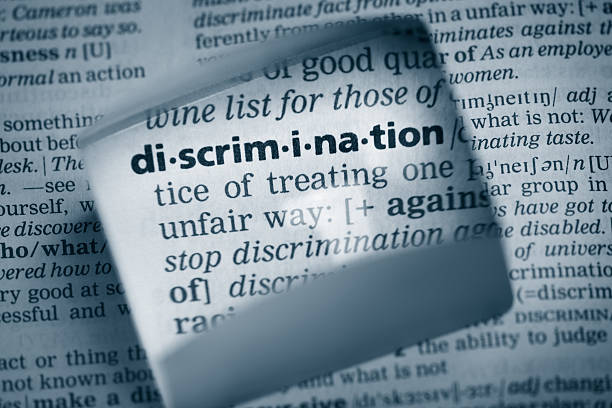- The Craziest Job Description on Reddit and What They Reveal About Hiring Today - December 16, 2025
- Beyond the Buzzword: What Recruiters Must Learn from the HiringLab AI Context Deficit Study - December 10, 2025
- Why So Many Job Descriptions Feel Fake or Misleading, According to Reddit - November 26, 2025
An anti discrimination policy in the workplace prevents discrimination and harassment of employees based on protected characteristics. The goal is to create a fair and inclusive work environment where every employee feels safe so they can give their best at their jobs. The policy details what counts as discrimination and bias. It also outlines the actions and consequences to properly address those behaviors.
According to Monster’s Workplace Discrimination Poll, about 91% of workers have faced workplace discrimination. In addition, 77% of workers have witnessed an act of workplace discrimination, yet 28% of workers don’t feel comfortable reporting an incident.
Why It’s Important to Create an Anti Discrimination Policy in the Workplace
- Ensures everyone gets the same chances, no matter their background. So, it builds a fair workplace where we listen to and respect all employees.
- Protects employees from workplace injustices and violations, reinforcing human rights.
- Ensures that your organization complies with its legal obligations to avoid costly lawsuits.
- A clear anti discrimination policy in the workplace guides HR to properly address discrimination complaints, reducing the risk of legal liability for discrimination claims.
- Demonstrate your dedication to ethical practices and protect your reputation. Discrimination can damage your brand image, causing you to lose customers, employees, and investors.
- Fosters a safer and more welcoming work environment. It also makes employees become more engaged and productive, improving employee morale and job satisfaction.
- Help attract more diverse candidates, resulting in a more competitive workforce with diverse skills and perspectives.
- Prevents absenteeism and turnover. Preventing discrimination with policies enhances employee well-being and reduces turnover, absenteeism, and rehiring costs.

How to Craft Your Anti-Discrimination Policies
Here are things to keep in mind when establishing or updating your anti-discrimination policies:
1. Ensure your policies are aligned with local, state, and federal anti-discrimination laws.
Stay current with legislation changes to keep your workplace policies current.
For more information, check out Prohibited Employment Policies/Practices published in the US Equal Employment Opportunity Commission. It includes rules against unfair employment practices like job ads, hiring, promotions, pay, discipline, and more. So, this covers everything from disabilities and pregnancy to dress code and harassment in the workplace.
2. Clearly define terms such as discrimination and harassment within your policy.
This helps employees know exactly what behaviors to avoid and understand the boundaries.
Show specific examples to help people identify behaviors to avoid and recognize potential discrimination or harassment situations.
Example: Adidas

Definitions
Discrimination is unjustly or unfairly denying equal treatment or opportunity to individuals or groups with respect to the terms, conditions, or privileges of employment based on any of the characteristics listed below. This unfair denial of equal treatment or opportunity can include but is not limited to hiring, firing, promoting, disciplining, scheduling, training, or deciding how to compensate an individual or group.
Discrimination arises where unfair treatment is predicated on any of the following actual or perceived characteristics:
- race, color, ethnic or national origin;
- age;
- religion;
- sex, sexual orientation, pregnancy or related medical conditions;
- gender identity, status, or expression;
- nationality, immigration status, citizenship, or ancestry;
- physical or mental ability condition or characteristics; or,
- any other basis prohibited under local law.
This list is not exhaustive and may be supplemented by local law.
Harassment is unwelcome and degrading, abusive, intimidating, or hostile verbal or physical conduct which unreasonably affects or interferes with an individual’s ability to do their work or creates a degrading, abusive, intimidating, or hostile work environment. Harassment can take many forms, including physical touching, violence or threats of violence, or offensive comments. It can also include inappropriate teasing or joking or displaying offensive images. Harassment can be a single act, incident, or statement, as well as a pattern or series of acts, incidents, or statements. Harassment can be based on any of the characteristics listed above. The list is not exhaustive and may be supplemented by local law.
Harassment may include:
- derogatory comments, nicknames, slurs, jokes, pranks, stereotypes, or insults;
- creating, sharing or displaying derogatory or otherwise inappropriate written materials, images, electronic messages, videos, or music;
- comments or behavior intended to threaten or intimidate; and
- other nonverbal behavior, including intimidation, stalking, or inappropriate staring, that threatens or reasonably could be perceived to threaten another.
Harassment also includes Sexual Harassment. Sexual Harassment is unwelcome conduct of a sexual nature which is degrading, abusive, intimidating, or hostile. Like Harassment, Sexual Harassment can be a single act, incident, or statement, as well as a pattern or series of acts, incidents, or statements.
Sexual Harassment may include:
- unwelcome sexual advances or requests for sexual favors, including any with an implicit expectation of reciprocation as a condition of employment, promotion, or advancement;
- creating, sharing, or displaying inappropriate written materials, images, electronic messages, videos, or music that reasonably could be interpreted to be sexual or obscene in nature;
- unwanted comments about personal or physical characteristics of any individual that reasonably could be interpreted to be sexual or obscene in nature; and
- other nonverbal behavior of a sexual or obscene nature, including unwelcome bodily contact, leering or inappropriate staring.
3. Use inclusive language
Inclusive language covers all prohibited protected characteristics like race, religion, age, gender, sexual orientation, disability, etc. so employees can understand which specific characteristics are protected.
Example: Google

Protected Status
Google prohibits discrimination or harassment based on certain characteristics, known as protected statuses. Protected status varies by location, but may include categories like, actual or perceived:
- race, color, ethnic or national origin;
- age;
- religion or religious creed (or belief, where applicable);
- sex, including pregnancy, childbirth, breastfeeding, or related medical conditions;
- sexual orientation;
- gender, gender identity, gender expression, transgender status, or sexual stereotypes;
- nationality, immigration status, citizenship, or ancestry;
- marital status;
- protected military or veteran status;
- physical or mental disability, medical condition, genetic information or characteristics (or
- those of a family member);
- status as a victim of domestic violence, sexual assault or stalking; or
- any other basis prohibited under federal, state, or local law
4. Establish clear and confidential reporting guidelines for employees who experience or witness discrimination.
Specify the channels where they file a complaint and outline the step-by-step process to file a complaint.
Provide assurance that they’ll be protected against retaliation so they’ll feel safe and supported when reporting incidents.
Example: JP Morgan

Employees who are aware of possible violations of this policy must immediately contact their Manager, Human Resources representative or report the incident via JPMorgan Chase’s Code Reporting Hotline. The Hotline is operated by an external company, staffed 24/7 and callers have the ability to identify themselves or report anonymously (where permissible by law). It can be reached by phone or via internet, mail or fax, and translation services are available on request. Managers who become aware of potential violations of this policy must immediately report the information to Human Resources.
Reporting obligations to the company do not prevent employees from reporting to the government or regulators conduct that they believe to be in violation of the law.
JPMorgan Chase is committed to promptly and effectively reviewing all potential violations and taking action to address as appropriate.
5. Give clear information for investigating complaints.
Outline the steps for this process and the expected timelines to all parties involved. Make sure that all investigations are performed promptly, thoroughly, and impartially.
Example: NYU

(a) The Investigation
The University will conduct a prompt, thorough and impartial investigation of a complaint as necessary and appropriate. The University will make every effort to complete its investigation within forty-five (45) days of a report of discrimination or harassment and will keep the investigation confidential to the extent possible. The investigator may find it necessary to extend the time period for completing an investigation in some circumstances. The investigator will provide the complainant, the alleged wrongdoer, and the business unit head with notice of any extension and where necessary and appropriate, give them a new timetable for completion of the investigation.
Where a complaint alleges a potential violation of the Policy, the investigation will include an interview with both parties, as well as the person who made the initial report, if different than one of the parties, and/or any other person who may have information regarding the incident, each of whom is expected to cooperate with any investigation. The investigator may also review relevant documents. Both parties will have an opportunity to be heard and present information.
The investigation process is strictly internal to NYU. Any union represented employee retains his or her right to have union representation during the investigation process.
(b) Findings and Recommendations
The investigator will report his or her findings to both parties and relevant managers and supervisors as may be appropriate.
Where the investigator concludes that a violation of this Policy has occurred, the relevant School or Department will take prompt and appropriate remedial action, including disciplinary action. Depending on the circumstances, disciplinary action may include (but is not limited to): reprimand/verbal counseling, training, censure, removal of privileges, letters of warning or suspension, and dismissal. Discipline for a violation of this Policy need not be progressive, so a first violation of this Policy may warrant suspension or discharge depending on the nature and severity of the conduct.
(c) Responsibilities of Management
In cases where an investigation confirms a violation of this Policy, management in the relevant School or Department must ensure that appropriate remedial action, which may include disciplinary action, is implemented. Managers must provide confirmation to their HRO within 14 days that the appropriate action has occurred. Management is also responsible for regular monitoring to ensure that all remedial and/or disciplinary steps are completed and no further discrimination or harassment occurs in the work environment.
(d) The Investigatory File
Every complaint will trigger the creation of an investigatory file. The investigatory file will consist of the initial complaint, the final investigative report, including a record of the remedial action to be taken, if any, and any documents created or used during the investigation. For the duration of the investigation, the OEO will maintain the investigatory file. Upon completion of the investigation, the OEO will close the file. Additionally, the OEO will record and maintain complaints in a database management file consistent with the NYU fiscal year (September 1st – August 31st). The OEO will maintain records of all complaints for a period of seven (7) years after the conclusion of an investigation.
Don’t forget to include a confidentiality clause to protect the privacy of both parties. It also encourages reporting by eliminating retaliation or embarrassment concerns when reporting discriminatory incidents.
Example: Adidas
The investigation team will treat all reports of suspected violations of this policy as confidentially as reasonably possible. The investigation team will only share confidential information to the narrowest extent possible when necessary to fully investigate a possible violation and then only on a need-toknow basis. Accordingly, this policy does not guarantee absolute confidentiality with respect to all reported violations and all details thereof.
6. Clearly state that your company prohibits retaliation against employee reporting discrimination or participating in investigations.
Explicitly state that retaliation is a separate violation with its own consequences.
Example: Google
Google prohibits retaliation for raising a concern about a violation of policy or law or participating in an investigation relating to a violation of policy or law. Retaliation means taking an adverse action against an employee or TVC as a consequence of reporting, for expressing an intent to report, for assisting another employee in an effort to report, for testifying or assisting in a proceeding involving sexual harassment under any federal, state or local anti-discrimination law, or for participating in the investigation of what they believe in good faith to be a possible violation of our Code of Conduct, Google policy or the law.
In some instances, it may not only be a violation of company policy but also against the law for one employee to retaliate against another for their participation in the complaint process. An adverse action may include, but is not limited to, discipline, termination or demotion.
We can’t guarantee a conflict free workplace. Googlers can and do discuss a variety of topics — work and non-work related — and often feel passionately about their discussions. If you report something that is not a policy violation and you believe you are being treated adversely as a result, you should feel free to report that, and we will look into it, but it may not amount to retaliation under this policy.
Explain the consequences of engaging in discriminatory behavior, harassment, and retaliation.
It may include disciplinary actions, which could lead to dismissal, depending on the severity of the offense.
Example: Whirlpool

We will not tolerate any harassment or discrimination in violation of this policy. If an investigation reveals that a violation of this policy or other inappropriate conduct has occurred, then the Company will take corrective action, including discipline, up to and including termination of employment, as is appropriate under the circumstances, regardless of the job positions of the parties involved. The Company may discipline an employee for any inappropriate conduct discovered in investigating reports made under this policy, regardless of whether the conduct amounts to a violation of law. If the person who engaged in conduct in violation of this policy is not a Whirlpool employee, then we will take whatever corrective action is reasonable and appropriate under the circumstances.
TIP:
State your company’s strong commitment to diversity, equality, and inclusion in your company’s mission and values. Use clear language to declare that your organization is against any form of discrimination, and discriminatory behavior will not be tolerated, regardless of the perpetrator or target. Show how your anti-discrimination stance aligns with your core values and overall vision for the company.
Example: Morgan Stanley

Commit to Diversity & Inclusion
Value individual and cultural differences as a defining strength
Champion an environment where all employees feel a sense of belonging—are heard, seen and respected
Expect everyone to challenge behavior counter to our culture of inclusion
Attract, develop and retain talent reflecting the full diversity of society
Example: JP Morgan Chase:
JPMorgan Chase is committed to maintaining a safe, productive, diverse, inclusive, professional, collegial and secure work environment in which all individuals are treated with respect and dignity. Discrimination, harassment or inappropriate conduct is not tolerated by or against employees, customers, vendors, contractors or any other individuals who conduct business with JPMorgan Chase.
Implementing Your Anti Discrimination Policy in the Workplace
Here are tips to guarantee the successful implementation of your anti-discrimination policy:
Get leadership commitment
Include the management team when creating your policy. So, ask for their thoughts on the policy and how it will be enforced. Also, make sure the policy aligns with your company’s mission and values, showing how it supports business goals. In addition, set goals and measures to track how well the policy is working. Then, after they approve it, ask for the resources needed to put the policy into action.
Lastly, have the CEO publicly endorse the policy to send a strong signal to employees that the company is serious about its anti-discrimination efforts.
Consult with experts
Meet with legal or human resources professionals with expertise in diversity and inclusion when crafting or updating anti-discrimination policies.
Include these people to make sure your anti-discrimination laws match the rules, thus, lowering legal risks. HR diversity experts keep up with the best ways to promote diversity, equity, and inclusion to prevent discrimination. They can also help customize your anti-discrimination policy to fit your company, culture, industry, and the people who work for you.
Communication and awareness
Communicate the anti-discrimination policies regularly. So, make them easily accessible by placing them on employee handbooks, the company’s intranet, the company newsletter, and the official website.
Discuss them during onboarding sessions and display them in common areas like break rooms and bulletin boards as gentle reminders for employees.
Train employees
For a more in-depth approach, arrange training sessions to teach about discrimination, its types, the results of such behavior, and how to report it. Also, make sure everyone, including the management, must attend the training.
In addition, start DEI campaigns to help people know more and understand. So, answer any questions employees have about the policy. Also, share stories and experiences from employees (with their permission) to show how the policy dealt with discrimination.
Encourage open communication and reporting
Set up ways for employees to report worries, like using anonymous hotlines, online forms, or talking to specific contacts. Also, make sure that those who report discrimination receive confidentiality and protection from any form of punishment or backlash.
So, regularly update employees on the status of the investigation and results to show transparency and commitment.
Monitoring Your Anti Discrimination Policy in the Workplace
Monitoring and evaluating your anti-discriminatory policy is important to know how effective it is and how it impacts employees and the whole organization. Here are ways to implement:
- Collect and analyze feedback and complaints
Keep tabs on the amount and type of complaints, including the protected traits and investigation outcomes. So, ask employees through surveys and focus groups to understand how well they grasp the anti-discrimination policy and if they think it works. Also, study the complaints and feedback to spot trends and patterns, finding places where the policy might need improvement.
After you put your policy into action, check how easy it is to use the reporting channels and see if they work well. Then, look at investigations to ensure fairness, timeliness, and effectiveness. So, keep an eye on how consistent and fair the disciplinary actions are.
- Consider other evaluation methods
You would also know if your anti-discrimination policy is working by assessing the changes in the engagement and retention rates among diverse employee groups.
You can also use external experts to conduct periodic audits of your anti-discrimination policy and practices.
- Share evaluation results
Share the results of your evaluation with the whole organization to be clear about the entire process. Also, be sure to highlight successes and admit areas where it can get better to show your commitment to improvement.
- Creating an action plan
Use the results of your assessment to set new goals and fix any problems in your policy. So, keep an eye on your progress to make sure your new plans match your goals. Also, stay up to date on the latest trends and best ways to promote diversity, equity, and inclusion, and be open to updating your anti-discrimination policy as you go.
Why I wrote this:
Creating an anti discrimination policy in the workplace is key to creating an inclusive workplace where everyone feels safe and protected. At Ongig, we do our best to promote an inclusive work environment by helping recruiters write job descriptions that attract more diverse applicants. Contact us for a demo.
